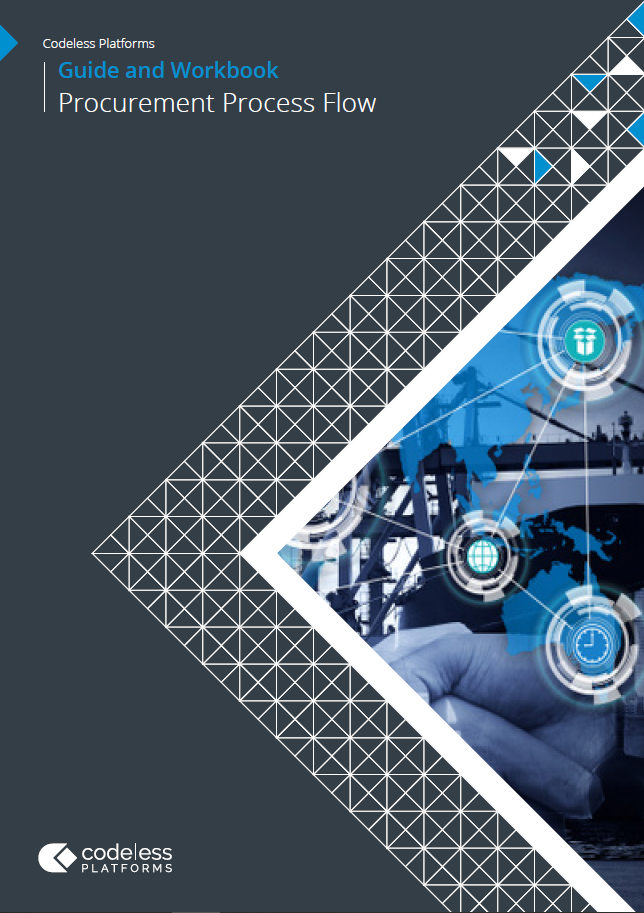- Procurement Process Flow
- What is procurement in business?
- Procurement vs purchasing – What’s the difference?
- What is procurement management?
- What is the procurement cycle?
- Procurement process flow: Mapping a procurement management process
- Cost saving strategies in procurement
- What is procurement software?
- Keeping supplier costs down with procurement bidding software
- Improving performance with procurement automation
- Procurement process automation: Next steps
Procurement Process Flow
Mapping a procurement process flow can often be an area of procurement management that is overlooked. In order to maximise profit margins and improve efficiency to stay cost competitive, mapping out your procurement procedure can help your business identify key areas that may require business process automation or modification and, ultimately, improve performance.
The following article will help you to produce a procurement process map that is unique to the way your business operates. To help you map your own procurement process model, the associated Procurement Process Flow Workbook can be used as a starting point to map your procurement processes and to help you identify areas where you can improve company and employee performance.
The Procurement Process Flow Workbook includes:
- BPMN Example: Procurement process flow overview
- Sub-process model: Preparation of procurement requirements and procurement procedure selection
- Sub-process model: Selection of key supplier(s) based on defined business rules
- Sub-process model: Registration of tenders and selection of supplier(s)
- Sub-process model: Review of financial costs, commitments and placing an order
- Note pages for you to map and modify your process models
- Process automation and data integration recommendations and considerations
What is procurement in business?
Procurement in business plays an essential role within an organisation. It is the process of cost effectively acquiring products or services from preferred suppliers. Procurement procedures and processes vary between organisations, with factors such as delivery time frames, product quality and profit margins being a major consideration in the procurement cycle.
The procurement procedure starts with the procurement department attaining relevant suppliers and agreeing terms to achieve the best possible purchase cost price for the business. When a business has a requirement for a specific product or service it initiates requests for proposals (RFP), either through direct negotiation or a head-to-head auction.
A typical procurement process includes:
- Identifying the needs of goods and services
- Finding suppliers
- Requesting proposals/quotations (RFP/RFQ)
- Negotiating with suppliers
- Agreeing terms with suppliers
- Arranging and receiving products/services
- Performing quality assurance
- Analysing results and margins
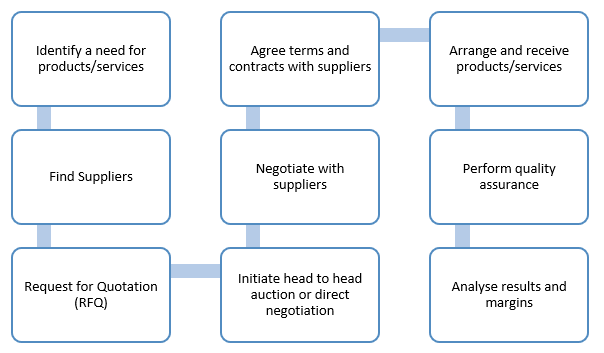
Diagram: Typical stages in a procurement process flow chart
Use the procurement process flow workbook to start planning the steps within your procurement process.
Procurement vs purchasing – What’s the difference?
Procurement and purchasing are two processes that both relate to the acquisition of goods and services for an organisation. Although they are similar and sit within the procurement function there is a difference.
Procurement in business is a strategic process of identifying the market for a product or service which includes sourcing and negotiating with suppliers, building relationships with suppliers and evaluating cost savings.
Purchasing is a sub-process of procurement and relates to the transaction phase of the procurement process. The purchasing phase includes the buying of goods or services, purchase orders, invoicing, shipping notifications, goods receipt and payment.
Procurement vs purchasing overview
- Identify need
- Source relevant supplier(s)
- Negotiate terms and contracts
- Build and maintain relationships
- Analyse and report on cost savings and profit margins etc.
Procurement: Strategic process
- Receive purchase requisitions
- Attain and evaluate quotes from suppliers
- Raise purchase order (PO)
- Receive goods/services
- Process payment to supplier
Purchasing: Transactional activities
What is procurement management?
Procurement management ensures that an organisation effectively identifies, sources and manages suppliers for the business to reach its strategic goals and objectives. The stages in a procurement procedure involves building supplier relationships to maintain service levels and ensuring the best possible cost price and profit margin for the organisation.
Supplier relationships play a crucial role in the success of an organisation and a well-structured procurement management process helps to ensure that service levels and expectations are met.
A typical procurement process includes:
- Researching existing and new markets and products
- Identifying relevant suppliers
- Negotiating supplier contracts and terms
- Evaluating supplier performance
- Resolving supplier issues and performance
- Maintaining supplier relationships
- Procurement Reports e.g. KPIs and supplier performance to senior management
To help the procurement department adhere to its processes and procedures and improve the management of suppliers, procurement software, such as ProcuraPro, provides complete visibility into all procurement tasks and activities and can help maintain inventory with the ability to automate procurement activities. Try ProcuraPro below.
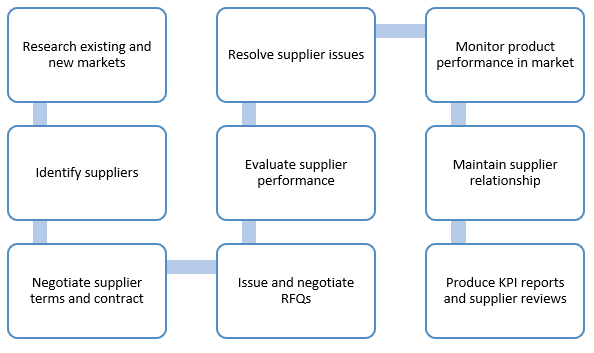
Diagram: Procurement management process flow chart
What is the procurement cycle?
A procurement cycle is the transition of tasks and processes that need to be performed throughout the procurement process. A successful and well thought out procurement and supply cycle can be the difference between success and failure. Management teams responsible for procurement in business need to implement company rules and procedures to ensure tasks and processes are performed successfully throughout the procurement process.
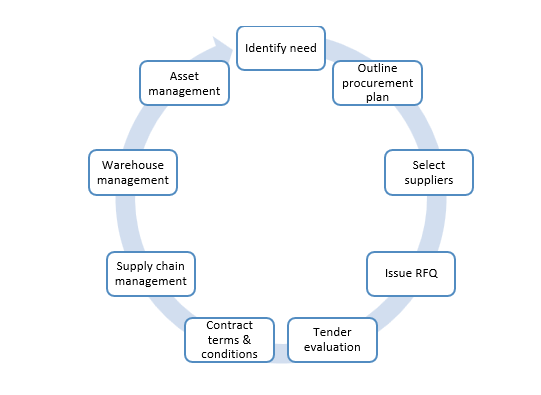
Diagram: Example of procurement cycle steps
Use the notes section within the Procurement Process Flow Workbook to outline the procurement cycle steps. Doing this will help you map your process flow.
The procurement cycle steps and procedures in place may vary depending on your business requirements and objectives. Typical procurement cycle steps include:
Identifying need
The procurement cycle starts with the business identifying a need for a product or service. The process of identifying a need may be an existing product that simply needs to be reordered or the introduction of a new product or service. Depending on the type of need, multiple departments and management teams could be involved. Cross departmental discussions may be needed to assess business necessity, research market requirements and to compile an audit of competitors.
Outline a procurement plan
The next step within the procurement cycle is to develop an overall strategy to bring the product or service to market. There are several considerations that can be included within your procurement plan; each of them will be outlined from company policies and structures, and will vary from business to business.
Within the procurement strategy it’s worth considering the type of supplier that you will use to fulfil the delivery of the product or service you require. Depending on your position within the market and the type of products or service you may want to explore local suppliers or large international suppliers that can provide the most cost effective and efficient service.
Once the type of supplier has been decided you may want to consider the tendering process. You can choose whether to entertain an auction tender, where suppliers will bid for your business, or, alternatively, enter direct negotiations with a selection of potential partners.
Additional considerations could include testing the market to help identify buying cycles, trends and market requirements. Additionally, time should also be spent creating the relevant documentation that will be sent for tender. For example, the documentation could include terms and conditions, product specifications, volumes and service agreements. Documenting specifications will help your suppliers quote accordingly to fulfil your requirements.
Selecting suppliers and issuing RFQs
Once your procurement management plan has been set out, the next stage is to identify relevant suppliers. Requesting for Information (RFI) provides you with the opportunity to gain relevant information from suppliers including size, financials and resources. Including an RFI within the procurement procedure and cross referencing the information received against your preferred supplier requirements will help you to determine whether a supplier meets the criteria to be included in the tender process.
Once the RFI stage is complete the next step is to issue a Request for Quotation (RFQ). An RFQ is sent out to preferred suppliers and includes details on the product or service required, volume and timescales. The RFQ stage can be initiated through a head to head auction or direct negotiation.
Tender evaluation process
A tender evaluation process starts when a supplier has submitted its tender bid. The tender evaluation includes assessing the supplier’s quality of products / service, fulfilment capabilities, timescales and financial details. Additional considerations can include the overall costs and any terms and conditions that may have been included.
Typically, a tender evaluation process includes:
- Price comparison
- Fulfilment capabilities
- Quality of product / service
- Reference checking
- Credit and financial checks
- Supplier audit
- Product / service sample or trial
- Cost evaluation
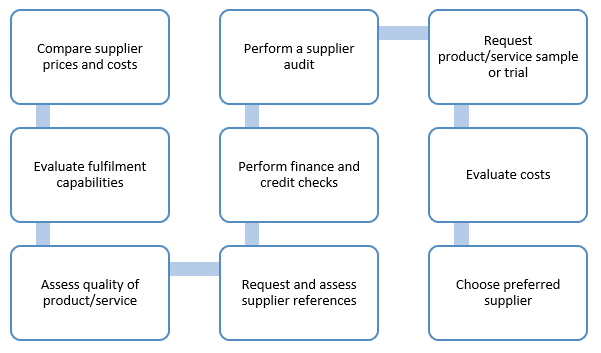
Diagram: Procurement tender evaluation process flow
Use the notes section within the Procurement Process Flow Workbook to detail your tender evaluation process.
Procurement contract and supply chain management
After the tender evaluation stage, and a preferred supplier has been selected, a procurement contract will need to be arranged. The procurement contract will specify terms and conditions including agreed timescales, costs and required stock levels to minimise risk.
The terms and conditions agreed within the procurement contract can be used as a marker against KPIs which will enable you to manage supplier relationships and resolve any potential issues that may arise during the procurement process. Maintaining a healthy relationship with your key suppliers can play an important role with future procurement needs. Maintaining key relationships can ensure continuity with your preferred products and services. It can also help with being first to market with a new product or service to get ahead of the competition.
Warehouse and asset management
Additional considerations within the procurement cycle include managing warehouse expectations and monitoring assets. The warehouse will have to consider fundamentals such as storage, product codes, delivery times and order processing. Assets will need to be monitored and reported against sales and marketing trends to asses existing and future business requirements for the product and services provided.
Procurement process flow: Mapping a procurement management process
A procurement process map is an effective way for a business to define its procurement in business processes and the steps involved within a procurement department. The aim of a procurement process flow chart is to help identify the exact process in which an organisation can obtain products and services efficiently and cost effectively. A clear and well defined procurement management process flow will help to minimise errors, save time and help to identify areas that can be automated to streamline procurement management processes.
Mapping your procurement process flow provides you with a clear overview of where your processes start and end. It will make it easier for you to identify gaps within your process models and highlight areas where your business could benefit from automation or improvement.
Get started on mapping your procurement processes by downloading the Procurement Process Flow Workbook below.
The procurement process flow below shows an overview of the procurement management process with its subsequent sub-processes. In this instance an employee requests products or services from a supplier.
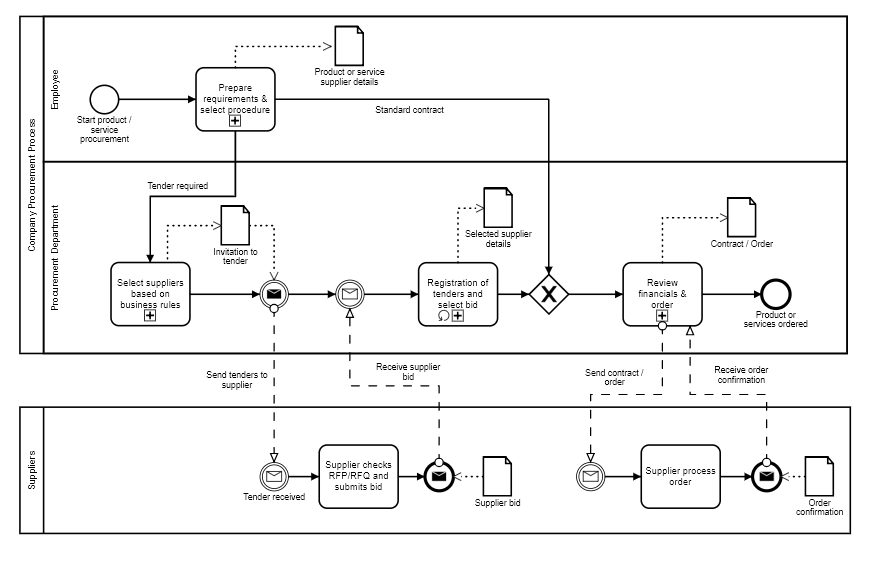
Diagram: BPMN example of procurement process flow overview
The procurement process can be broken down into the following four sub-processes:
- Preparation of procurement requirements and selection procedure
- Selection of key supplier(s) based on defined business rules
- Registration of tenders and selection of supplier(s)
- Review of financial costs, commitments and placing order
Procurement process flow business rules example
Below is an example of business rules within the procurement process.

Procurement process flow: Sub processes
1. Prepare requirements and selection procedure
The below procurement management process flow details the sub-process to prepare the procurement requirements and the selection of the desired procedure to follow. Each procurement process will have different business rules which are dependent on specific contract agreements. For example, if a procurement department already has a framework agreement with a specific supplier there is no need to go to tender. If no prior agreement is in place the procurement requirement will go to tender in either a head-to-head auction or direct negotiation.
To learn how to map this step for your organisation download the workbook.
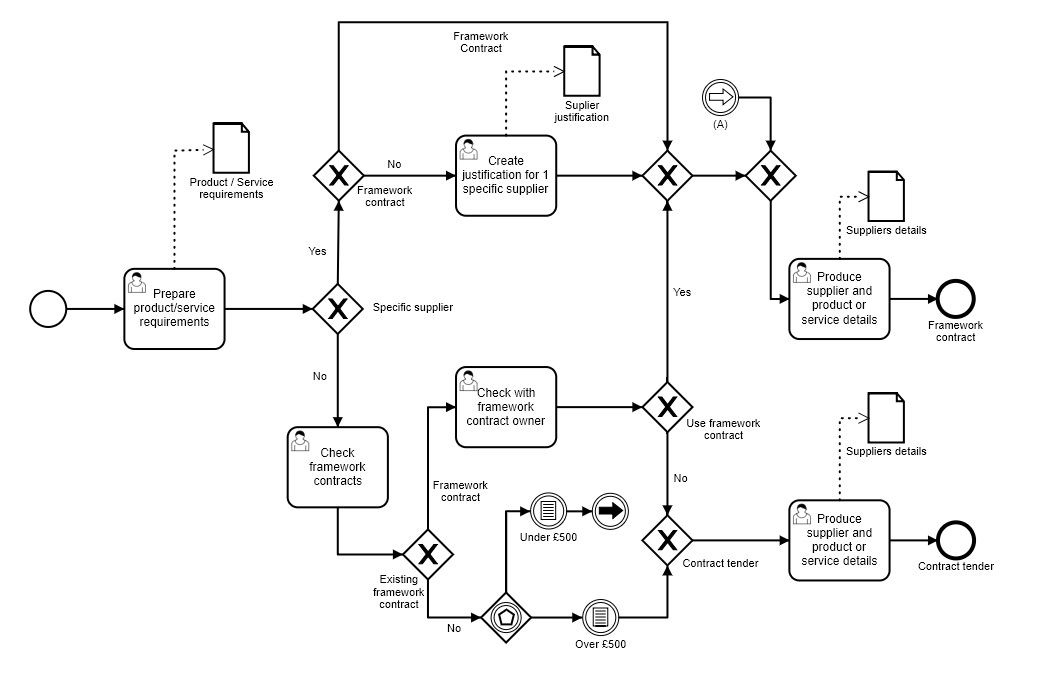
Diagram: Procurement process flow – Preparing requirements and selecting procurement procedure
2. Selecting the number of suppliers based on business rules
The procurement management process flow below details the sub-process of selecting suppliers based on the detailed business rules (above). Procurement business rules will vary depending on an organisation’s procurement needs and requirements. For this example the conditions are under £5,000, over £25,000 and under £50,000.
To map this step for your organisation download the workbook.
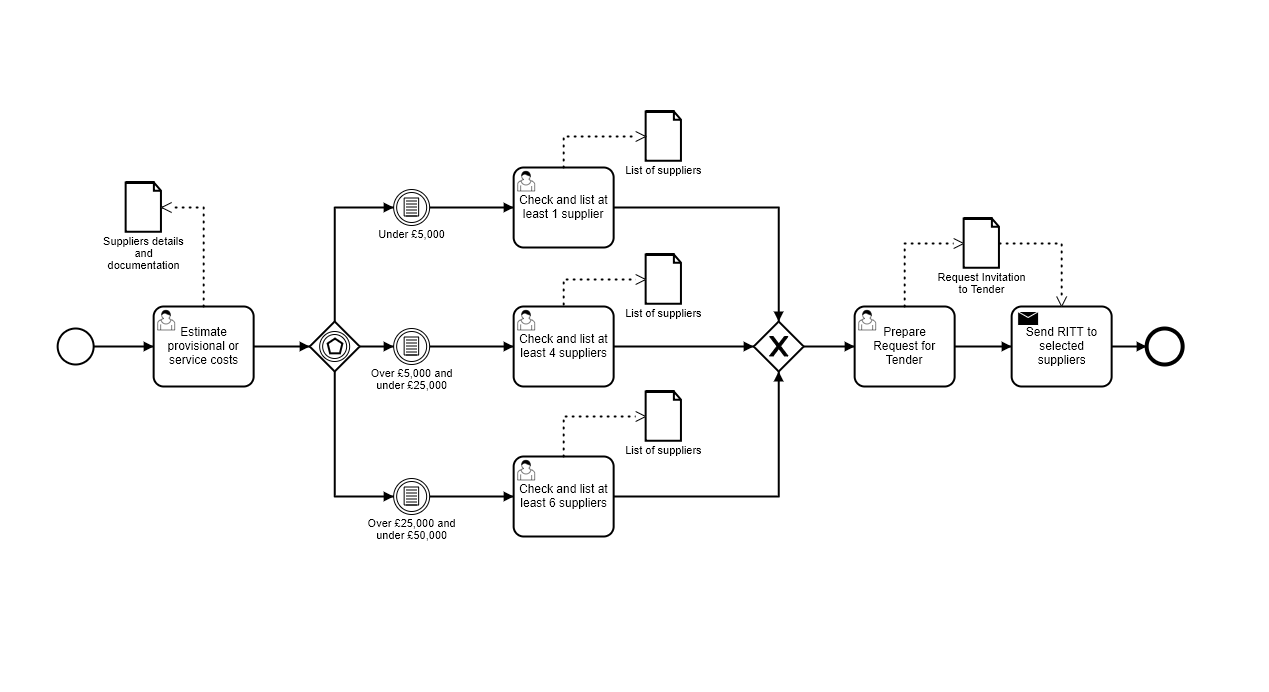
Diagram: Procurement process flow – Select number of suppliers on business rules
3. Registration of tenders and selection of supplier(s)
The procurement process map below details the sub-process of registering tenders and selecting suppliers to fulfil the product or service requirement. The tender selection process will have specific and predetermined criteria in place. Additionally, tenders are stored until the predetermined criteria before opening e.g. time and date.
To map the registration of tenders and selection of suppliers process for your organisation download the workbook.
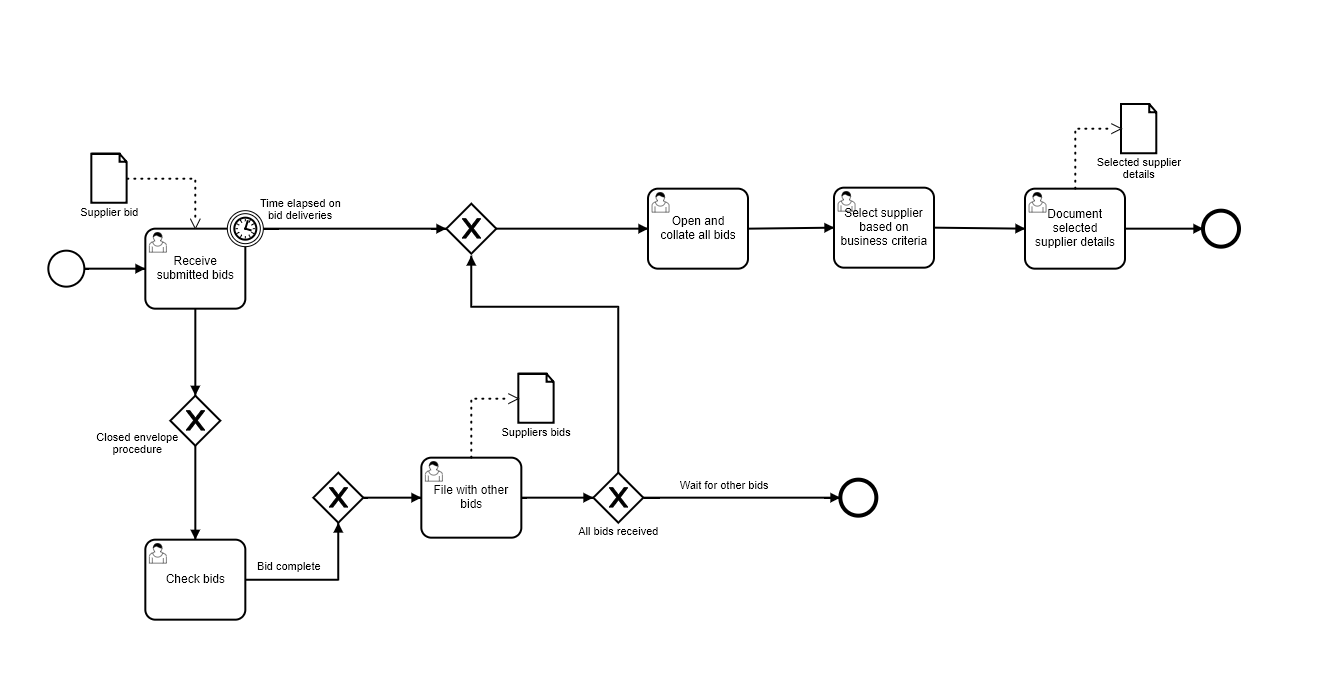
Diagram: Procurement process flow – Registration of tenders and selecting supplier
4. Review of financial costs, commitments and placing an order
The procurement process flow below shows the sub-process of reviewing financial commitments and placing an order with the supplier. To map the process of reviewing financial commitments and placing an order with a supplier download the workbook.
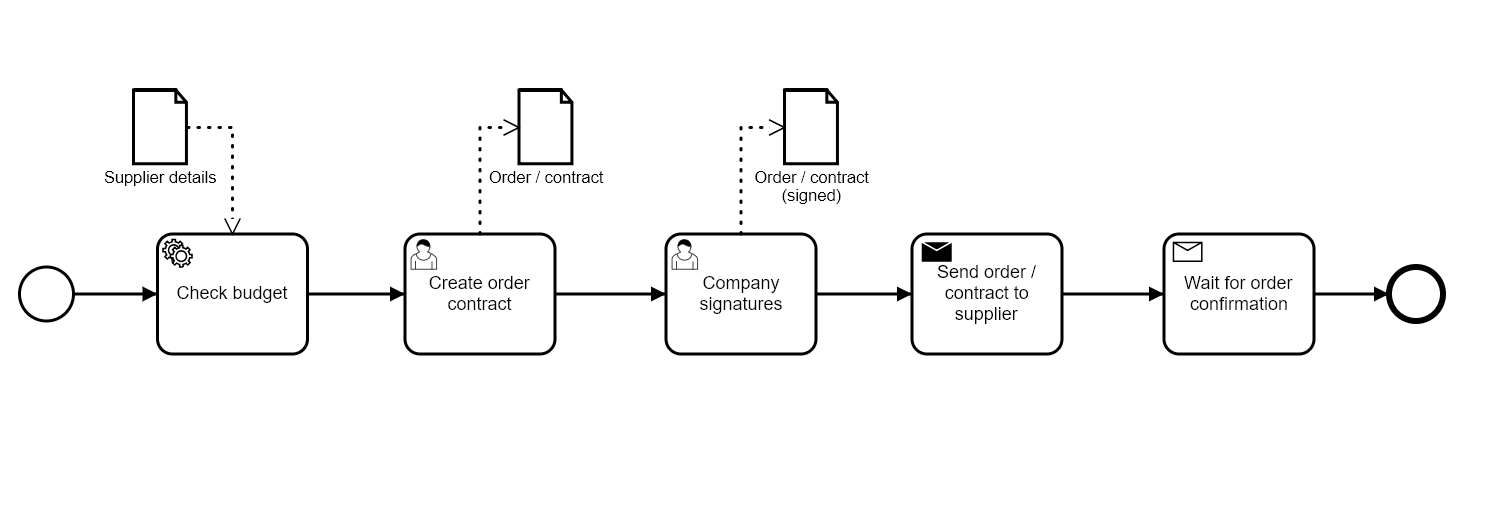
Diagram: Procurement process map – Review financials and order products
Get started on mapping your procurement process by downloading the Procurement Process Flow Workbook and outline the difference stages within your top-level overview and associated sub-processes.
Cost saving strategies in procurement
The overall objectives of the procurement department are to keep procurement costs low, maintain supplier relationships and reduce the overall price of products and services. Any procurement department will have to consider the influence different suppliers and product quality may have on their organisation. For example, a product that is low-cost and of low quality may be detrimental to the organisation’s position within the marketplace. A product or service that is provided by a reputable provider can be a larger initial cost, but can help to sustain or increase an organisation’s reputation within its market sector. Selecting suppliers with the most cost-effective return on investment for the goods and services provided means that clear and concise decision making is vital.
Procurement departments need to be able to make the correct decisions regarding suppliers. If an organisation sticks to its pre-defined procurement plan, where budgets, costs and targets are agreed in principle, it will not only aid the decision-making process but will help to stick within budget and keep procurement costs low. Additionally, having the most up-to-date information available at any given moment in time will aid the decision-making process.
Streamlining procurement processes by utilising procurement software can help enhance decision making by increasing the visibility of critical information such as RFQs, emails and communication, contracts and reports. Procurement software will also help to reduce data entry, allowing employees to concentrate on value-added tasks elsewhere within the procurement cycle.
Cost reduction for procurement in business plays a critical role in driving company revenue growth and helping an organisation to reach strategic and commercial targets. This can be achieved several ways, including:
- Perfecting the art of negotiation
- Investing in procurement software
- Integrating existing systems and business applications to automate processes
- Actioning head-to-head auctions when issuing an RFQ
- Reviewing existing supplier terms, conditions and discounts etc.
- Assessing and reviewing delivery frequency and purchasing volumes
- Reviewing stock levels in the warehouse, in-store and online
- Assessing product quality and specifications against purchase cost and ROI
What is procurement software?
Procurement software enables an organisation to improve the procurement management process. Procurement software provides complete visibility into all procurement tasks and activities and can help maintain inventory with the ability to automate procurement activities.
Procurement solutions simplify administration processes such as workflow approval for purchase orders and invoicing. Many procurement systems include the tender process as an additional module within the application. This means that the procurement department can quickly and easily issue and review an RFQ, whether it has been through a head-to-head auction or direct negotiation.
Common modules within procurement software include:
- Supplier details e.g. primary contacts, company overview
- Supplier contract management
- Ability to initiate supplier RFQ
- Supplier portal e.g. review, update and submit RFQs
- Workflow approvals
Typical benefits of procurement software include:
- Streamlined administration processes
- Improved monitoring and reporting
- Increased visibility of critical procurement data
- Quick and easy access to supplier information
- Improved audit and communication trails
Learn more about how procurement software can help you to improve company performance by downloading the brochure below.
Keeping supplier costs down with procurement bidding software
Procurement bidding software, such as ProcuraPro, enables the creation of competitive, time restricted bidding events for suppliers that meet your exact requirements, including price, quality, quantity, fulfilment times etc.
Procurement bidding software allows suppliers to review RFQs and place a bid for your contract quickly and simply by logging into a supplier portal. You can choose whether or not to publicly disclose which suppliers have bid and the value they have submitted. The preferred supplier can then be selected within the procurement software and be processed all from one simple-to-use application.
One of the key advantages of utilising head to head auctions within the RFQ process is that it enables an organisation to create competitive, time-restricted bidding events for suitable suppliers that meet exact criteria. Procurement bidding software helps you to keep procurement costs down whilst streamlining communication and administration processes.
Standard features that you should look for in procurement bidding software include:
- Initiate requests for proposals (RFP) and quotations (RFQ)
- Invite suppliers by automatically generating and sending emails
- Select qualified proposals and invite suppliers for negotiation stage
- Internally approve, then inform winning supplier(s) via email
- Receive email updates about suppliers’ activity on proposals
- Suppliers can place proposals in response to a received RFP/RFQ
- Suppliers can view their RFP/RFQ and compare it with other proposals
- Suppliers can update their own price proposals in response to competition price updates
For more information on how to improve your procurement process with procurement bidding software, try the software for free or download the data sheet below.
Improving performance with procurement automation
Procurement automation streamlines the procurement process and removes repetitive and manual administration activities from employee workloads. Automating procurement tasks helps to improve efficiency and decision making by increasing the visibility of critical data, reducing supplier costs and improving the management of suppliers. An automated procurement system will enable employees to concentrate on other activities that add value to the business such as procurement strategy and supplier management.
There are several ways to automate the procurement process including:
- Integrating procurement software with accounting, ERP and WMS systems
- Integrating with Electronic Data Interchange (EDI) software
- Automating RFQs when stock levels reach reorder points
- Automating stock level reorder point notifications via email or SMS
- Automatically creating and distributing purchase orders and order confirmations
Learn how integrating procurement software with your other business systems reduces supplier costs, helps control spending decisions, improves lead times and removes repetitive administration tasks by downloading the brochure below.
Procurement process automation: Next steps
For more information on how to streamline your procurement process through procurement automation, utilising procurement software or mapping your procurement process flow, download the related resources below or call us on +44 (0)330 99 88 700.
Try ProcuraPro ProcuraPro Data Sheet Procurement Integration
